Photographer and filmmaker Arkadiusz Podniesinski visits Fukushima
 Print This Print This
By Arkadiusz Podniesinski
Arkadiusz Podniesinski
Sunday, Dec 27, 2015
MADE IN JAPAN
When I visited Chernobyl for the first time 7 years ago, I didn’t think that a similar disaster could take place anywhere ever again, and certainly not in Japan. After all, nuclear power is safe and the technology is less and less prone to failure, and therefore a similar disaster cannot happen in the future. Scientists said this, firms that build nuclear power stations said this, and the government said this.
But it did happen.
When I was planning my trip to Fukushima I didn’t know what to expect. There the language, culture, traditions and customs are different, and what would I find there four years after the accident? Would it be something similar to Chernobyl?
THE DISASTER
This photographic documentary is not intended to tell the story of the events surrounding the disaster yet again. Like the incident that occurred on 26 April 1986, most readers know the story well. It is worth mentioning one very important aspect, however, which is an essential issue as we consider the story further. It is not earthquakes or tsunami that are to blame for the disaster at the Fukushima Daiichi nuclear power station, but humans. The report produced by the Japanese parliamentary committee investigating the disaster leaves no doubt about this. The disaster could have been forseen and prevented. As in the Chernobyl case, it was a human, not technology, that was mainly responsible for the disaster.
As will be seen shortly, the two disasters have much more in common.
RADIATION OR EVACUATION
Immediately after the disaster at the Fukushima power station an area of 3 km, and later 20 km, was designated from which approximately 160 000 residents were forcibly evacuated. Chaos, and an inefficient system of monitoring radiation levels, resulted in many families being divided up or evacuated to places where the contamination was even greater. In the months and years that followed, as readings became more precise, the boundaries of the zone evolved. The zone was divided up according to the level of contamination and the likelihood that residents would return.
Four years after the accident more than 120 000 people are still not able to return to their homes, and many of them are still living in temporary accommodation specially built for them. As with Chernobyl, some residents defied the order to evacuate and returned to their homes shortly after the disaster. Some never left.
 |
| Changes in the boundaries of the zone between the years 2011 and 2015 |
It is not permitted to go to towns and cities located in the zone with the highest levels of contamination, marked in red, except with a special permit. Due to the high level of radiation (> 50 mSv/y), no repair or decontamination work is carried out there. According to the authorities’ forecasts the residents of those towns will not be able to return for a long time, if at all.
The orange zone is less contaminated but also uninhabitable, but because the level of radiation is less (20-50 mSv/y) clearing up and decontamination work is being done here. Residents are allowed to visit their homes but are still not allowed to live in them.
The zone with the lowest level of radiation (< 20 mSv/y) is the green zone, and decontamination work has been completed here. Now the clean-up is in its final stages, and soon the evacuation order is to be lifted.
DECONTAMINATION
When entering the zone, the first thing that one notices is the huge scale of decontamination work. Twenty thousand workers are painstakingly cleaning every piece of soil. They are removing the top, most contaminated layer of soil and putting it into sacks, to be taken to one of several thousand dump sites. The sacks are everywhere. They are becoming a permanent part of the Fukushima landscape.
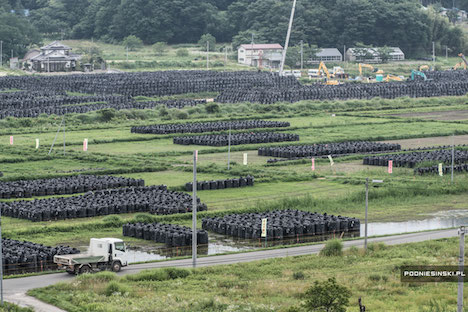 |
| Dump sites with sacks of contaminated soil are usually located on arable land. To save space they are stacked in layers, one on top of the other. |
 |
| Millions of sacks. Aerial view. |
The decontamination work does not stop at removal of contaminated soil. Towns and villages are being cleaned as well, methodically, street by street and house by house. The walls and roofs of all the buildings are sprayed and scrubbed. The scale of the undertaking and the speed of work have to be admired. One can see that the workers are keen for the cleaning of the houses to be completed and the residents to return as soon as possible.
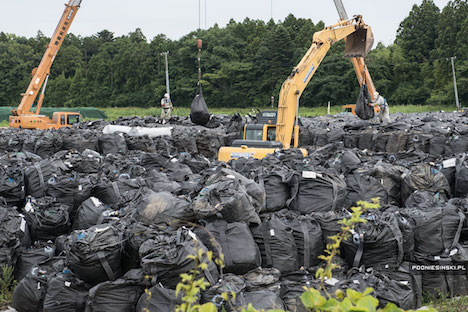 |
| One of thousands of dump sites with sacks of radioactive soil |
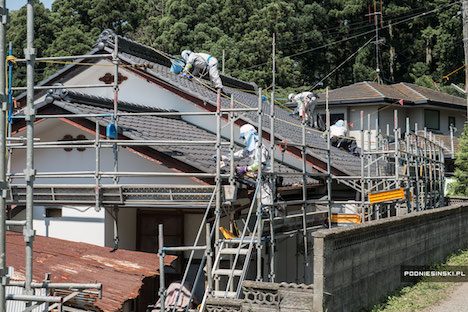 |
| By hand, the roofs of all the buildings are cleaned one by one |
What the workers, and in fact the government financing their work, want to achieve is not necessarily what the residents themselves want. The contaminated land is not reused, and doesn’t even leave the zone. It is only transported out of the town often not beyond the outskirts. This expensive operation is only the shifting of the problem from one place to another, just so long as it is outside of the town to which residents are soon to return.
It is still not clear where the contaminated waste will end up, especially as the residents protest against long-term dump sites being located near their homes. They are not willing to sell or lease their land for this purpose. They do not believe the government’s assurances that in 30 years from now the sacks containing the radioactive waste will be gone. They are worried that the radioactive waste will be there forever.
 |
| Residential building with a view over one of the waste dumps with radioactive soil |
Many areas cannot be decontaminated at all because of thick forests or because they are mountainous. Only houses and areas surrounding the houses, and 10-metre strips along the roads, are decontaminated. This gives rise to the reasonable fear on the part not only of residents, but also of scientists, that any major downpour will wash radioactive isotopes out of the mountainous, forest areas and the inhabited land will become contaminated again. The same is true of fire, which, helped by the wind, can easily carry radioactive isotopes into the nearby towns. These fears are not without foundation, over the last year this has happened at least twice in Chernobyl.
Given the situation, the attitude of the residents, who are distrustful of the authorities, are worried about contamination, and do not want to return to their homes, is no surprise. A survey carried out on former residents of the red zone shows that only 10% of those polled want to return to their homes, while as many as 65% of evacuees do not intend to go back. In fact, what do they have to return to? The lack of work, infrastructure, and medical care is an effective deterrent to returning even for the most optimistic residents, and with each year that passes this will be more difficult; the residents get older, like the deserted houses they are not renovating. Are the towns to remain deserted forever?
There are also reasons for an unwillingness to return that residents do not like to talk about, and this is the compensation and the various types of subsidies and tax relief that evacuees receive. The compensation for the moral wrongdoing alone, that every evacuee gets, is 100 000 yen (approximately 850 dollars). Some residents have protested, and are even taking legal action against the government, which intends to stop compensation one year after a zone (the green and orange zones) is opened. The residents are scared that the authorities’ actions are an attempt to coerce them into returning, especially as the government arbitrarily raised the permitted level of exposure to radiation per year from 1 to 20 mSv.
NO-GO ZONE
The decision not to come to Fukushima until four years after the disaster is a deliberate one, as most of the destruction caused by the earthquake and tsunami has been cleared up. Above all, I would like to focus on the accident at the nuclear power station and the effects it had on the environment and the evacuated residents, and compare it to Chernobyl. For this reason, what I would like to do the most is see the orange zone and the red zone, the most contaminated and completely deserted. In the latter, no clearing up or decontamination work is going on. Here time has stood still, as if the accident happened yesterday.
A separate permit is required for each of the towns in the red zone, which is issued only to people who have a legitimate, official reason to go there. No tourists are allowed. Even journalists are not welcome. The authorities are wary, they enquire after the reason, the topic being covered, and attitude towards the disaster. They are worried that journalists will not be accurate and objective when presenting the topic, but they are most likely scared of being criticized for their actions.
I try to arrange entry into the no-go zone while still in Poland. I get help from colleagues, authors of books, and journalists who write about Fukushima. They recommend their friends, they recommend their friends, and they recommend their friends. It is not until I travel to Fukushima and spend two weeks there that I am able to make contact with the right people. It turns out that the knowledge I have and the photographs I have taken in my career from numerous visits to Chernobyl convince these people to help me.
While I am waiting for the permits to be issued I visit the towns in the orange zone. It takes me two days to find the house of Naoto Matsumura, a farmer who returned illegally to the zone, which at that time was still the red zone, not long after the accident. He returned to take care of the abandoned animals. He gives the reasons for returning, saying that he could not bear to see whole herds of cattle wandering aimlessly in the empty streets when their owners had fled the radiation. He tells of how they were starving to death or were being killed and used for recycling by the authorities. What have they done wrong that makes it right to kill them for no reason – he asks, trying to explain why he returned illegally.
When Matsumura finds out that I visit Chernobyl regularly, the person asking the questions quickly becomes the person being asked them. Matsumura is curious about how the evacuation was carried out in Chernobyl, how decontamination was carried out, and the level of radiation. He asks specific questions, enters into a discussion, compares the radiation levels. It is clear that due to the Fukushima disaster he learnt the professional terminology and terms relating to the issue. Unfortunately time flies relentlessly and Matsumura has to get back to his duties. We arrange to meet again in the autumn.
It is still illegal for residents to return permanently to towns located in the orange zone. They are only allowed to spend time there in the daytime, but even during the day it is hard to find any residents here. Most do not want to return, and soon they won’t have anything to come back to. Many of the deserted houses, especially the wooden ones, are in such a state of disrepair that soon it will be not be financially viable to renovate them, and if they are not renovated they will start to fall down. Maybe this is a conscious choice on the part of the residents, who allow this to happen because they have already made up their minds never to return to them?
Young residents or families with children left Fukushima long ago. In pursuit of a better life, a better future, they went to Tokyo or other large towns. The older residents, more attached to the place they have lived for several decades, prefer to live nearby, in specially built temporary housing. Others went to relatives, but not for long, so as not to be a burden. They return to their temporary housing, two tiny rooms and a kitchen in the hall.
Youko Nozawa takes me to the temporary housing she was moved to after weeks of moving from place to place during the evacuation. Being invited inside is quite a privilege and a demonstration of trust for the Japanese, who value their privacy.
NAMIE
A week later I have the permit in my hand and can finally make my way to Namie, one of three towns in the no-go zone. Although the town is completely deserted, the traffic lights still work, and the street lamps come on in the evening. Now and again a police patrol also drives by, stopping at every red light despite the area being completely empty. They also stop next to our car and check our permits carefully.
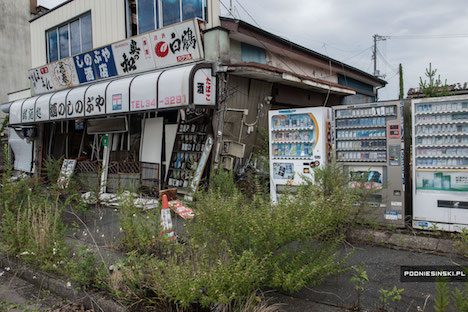 |
| Off-licence |
I am accompanied by three Namie residents who want to show me the houses they were evacuated from. The earthquake did not do any serious damage to the houses, and being situated a long way from the ocean they were also not at threat from the killer tsunami wave. It was only the radioactive cloud that forced residents to flee.
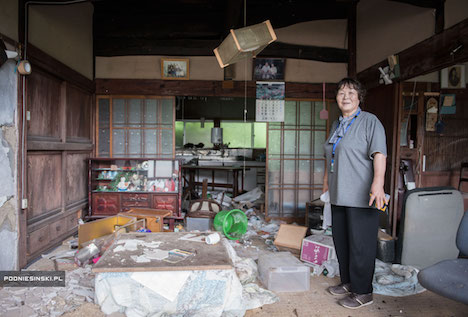 |
| Inside the house |
In order to see the effects of the tsunami we go to the coast, where all of the buildings were destroyed. Although four years have passed, the clean-up is still going on, although most of the damage has now been cleared up. Behind the buildings one concrete building stands out, which was capable of withstanding the destructive force of the tsunami. It is a school, built using TEPCO money, where the schoolchildren luckily survived by escaping to the nearby hills.
The primary school building that survived is situated a mere 300 metres from the ocean. On the tower, as in all of the classrooms, there are clocks which stopped at the moment the tsunami came (at the time the power went off).
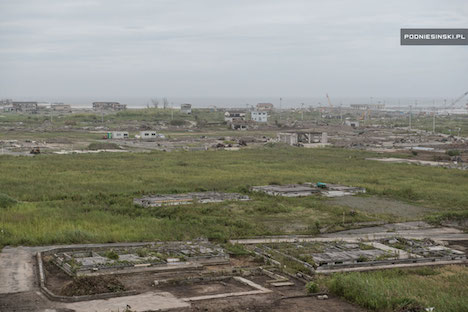 |
| Remains of destruction in the aftermath of the tsunami. A photograph from the school’s observation tower. |
Finally we visit Masami Yoshizawa’s farm, who, like Matsumura, returned to his ranch shortly after the disaster to take care of the abandoned animals. Yoshizawa’s story is more interesting, however. Not long after the accident his cows started to get mysterious white spots on their skin. Yoshizawa suspects that this is due to the cows eating contaminated grass. He is trying to publicise the case, he is in contact with the media, and protests in front of the Japanese parliament, even taking one of his cows. Unfortunately, apart from financial support and regular testing of the cows’ blood, there is no one who is willing to finance more extensive tests.
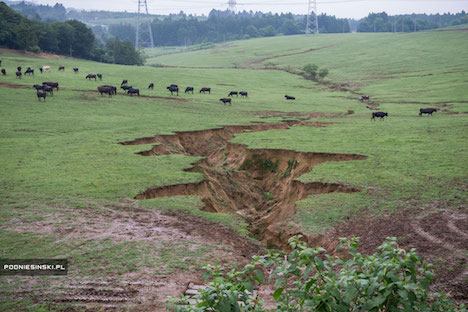 |
| There are currently approximately 360 cattle on Masami Yoshizawa’s farm. The cracks in the earth were caused by the earthquake. |
There are currently approximately 360 cattle on Masami Yoshizawa’s farm. The cracks in the earth were caused by the earthquake.
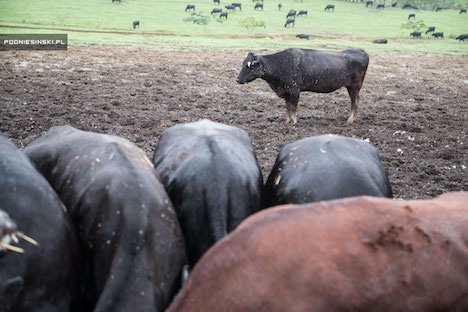 |
| One of the cows with spots on its skin |
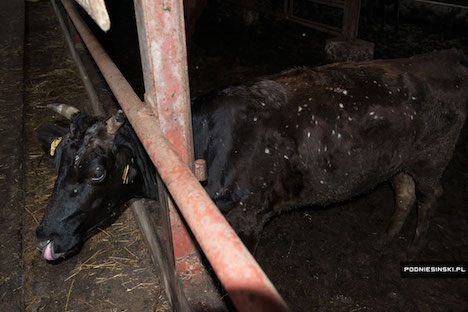 |
| Another cow with spots, inside the cowshed |
FUTABA
Another week of waiting and finally I receive the permit to go to Futaba, another town in the no-go zone. This town, which borders the ruined power station, is the town with the highest level of contamination in the zone. There has not been any clearing up or decontamination due to the radiation being too high. For this reason we are also issued with protective clothing, masks, and dosimeters.
The town’s close ties with the nearby power station are not just a question of the short distance between them. Next to the main road leading to the town centre I come across a sign across the street, and in fact it is a slogan promoting nuclear energy, saying „Nuclear energy is the energy of a bright future” – today it is an ironic reminder of the destructive effects of using nuclear power. A few hundred metres further on there is a similar sign.
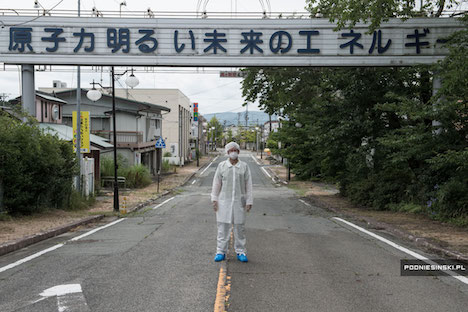 |
| A message of propaganda above one of the main streets of Futaba – „Nuclear energy is the energy of a bright future” |
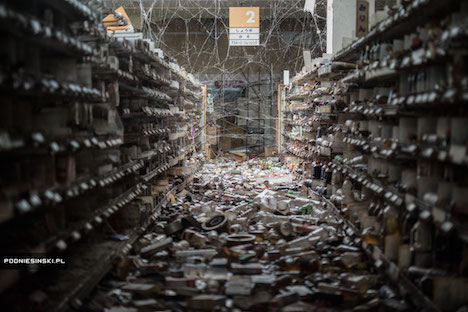 |
| Supermarket |
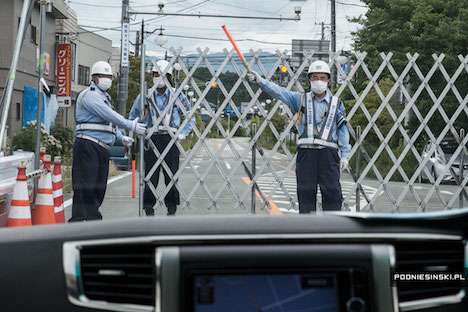 |
| Checkpoint |
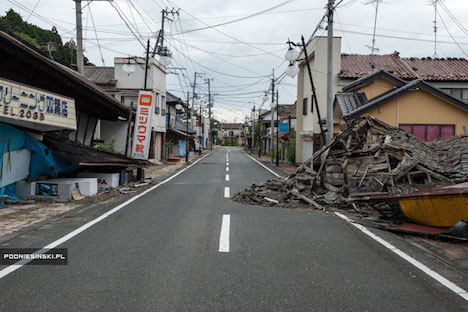 |
| Deserted streets in Futaba |
While I am in Futaba I am accompanied by a married couple, Mitsuru and Kikuyo Tani (aged 74 and 71), who show me the house from which they were evacuated. They visit it regularly but due to the regulations they can do this a maximum of once a month, and only for a few hours at a time. They take advantage of these opportunities even though they gave up hope of returning permanently a long time ago. They check to see if the roof is leaking and whether the windows have been damaged by the wind or wild animals. If necessary they make some minor repairs. Their main reason for returning however is sentimental and the attachment they feel to this place. A yearning for the place in which they have their origins and spent their entire lives.
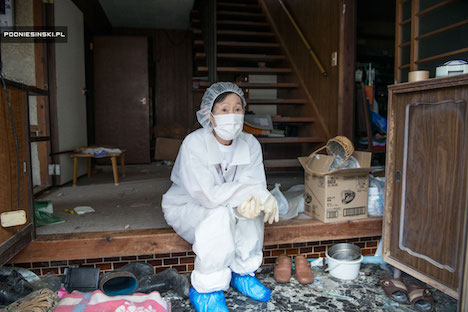 |
| Kikuyo Tani in front of the entrance to her house |
When visiting Futaba, which borders the damaged nuclear power station Fukushima I, I can’t help but try to photograph the main culprit of the nuclear disaster, but unfortunately all of the roads leading to the power station are closed and are heavily guarded. With a little ingenuity one can see it, however. But first I go to see a nearby school.
In the vicinity of the red zone I happen to notice an abandoned car. It is hard to make it out from a distance, it is almost completely overgrown with green creepers. When I get up closer I notice that there are more vehicles, neatly organised in several rows. I guess that the cars became contaminated and then were abandoned by the residents. A moment later the beep of the dosimeter confirms this.
INTERIORS
While I am in the zone I devote a lot of time and attention to taking photographs of the interiors. Photographs of this kind give a very good illustration of the human and highly personal dimension of the tragedy. They also make us aware of what the residents of Fukushima lost and the very short time they had for the evacuation. When taking photographs of the interiors of the buildings the similarities to Chernobyl are even more striking, although in Chernobyl, after almost 30 years since the disaster and thousands of tourists visiting it, it is hard to find any untouched objects. One time a teddy bear is lying completely covered with gasmasks, and a month later it is next to the window, put there so that a tourist could take a photograph in better light. These are things that were staged subsequent to the incident. In Fukushima, the disaster remains seared into the memories of residents, the evacuation order still in force, and the total lack of tourists mean that everything is in the same place as it was four years ago. Toys, electronic devices, musical instruments, and even money, have been left behind. Only a tragedy on this scale can produce such depressing scenes.
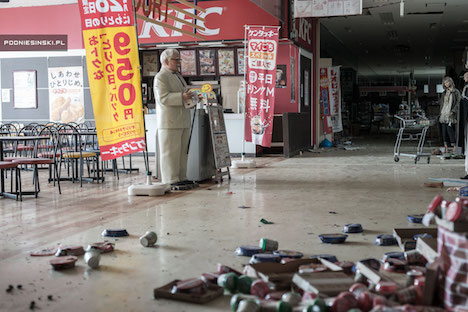 |
| KFC |
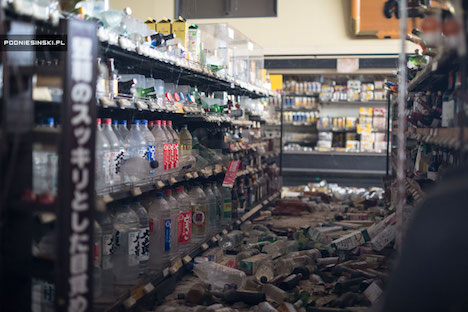 |
| Off-licence |
 |
| Hairdresser |
 |
| Supermarket |
CONCLUSION
I came to Fukushima as a photographer and a filmmaker, trying above all to put together a story using pictures. I was convinced that seeing the effects of the disaster with my own eyes would mean I could assess the effects of the power station failure and understand the scale of the tragedy, especially the tragedy of the evacuated residents, in a better way. This was a way of drawing my own conclusions without being influenced by any media sensation, government propaganda, or nuclear lobbyists who are trying to play down the effects of the disaster, and pass on the information obtained to as wider a public as possible.
This was only the first trip, I am coming back to Fukushima in the autumn, and there is nothing to suggest that I will stop in the near future. This should not be understood as a farewell to Chernobyl, I will be visiting both places regularly.
Seven years ago I ended my first documentary on Chernobyl with these words:
"An immense experience, not comparable to anything else. Silence, lack of cries, laughter, tears and only the wind answers. Prypiat is a huge lesson for our generation."
Have we learnt anything since then?
 |
| Leaving the zone |
For additional pictures, see the photographer's archive here.
Source URL
|
 Print This Print This

|

